|
Who Has the Real Lladró?
| By Peggy Whiteneck
Posted June 2013
|
 |
It was in the early 1950s that, unlikely as it sounds, three poor sons of a farm family in the Valencia region of Spain started a porcelain empire, establishing several brands, inspiring countless other unaffiliated imitators, and becoming rich and internationally famous in the process. By the 1980s, the United States had become Lladró’s biggest export market, though not its only one. Today, while its production facilities remain in Spain on a campus so large it is referred to as “Porcelain City,” Lladró also has retail outlets throughout Europe and Asia and has expanded its holdings to include assets in real estate, energy, finance and fine jewelry.
Famous Lladró attributes. Lladró made figurines in both glazed and matte (unglazed) porcelain, as well as in a semi-porcelain formula called Gres, which combined earth-toned matte surfaces with enamel-painted surfaces. Although Lladró has produced everything from vases to thimbles and lamps to candleholders, it is most famous for its figurines of people, animals and birds.
Its usual color palette of pale and neutral pastels is often cited as a distinctive characteristic, but that is easily imitated by other non-Lladró brands. What distinguishes Lladró is not the palette but the quality of the painting and modeling, especially around faces, which are rendered with exquisite delicacy. Lladró faces are, quite simply, inimitable.
|
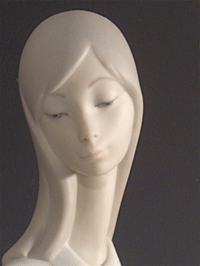
|
The inimitable detail in a Lladró face will always show it is not a reproduction. (All photos are from the collection of Peggy Whiteneck.)
|
Lladró is further distinguished by the technical risks it takes in the ways that its models occupy space. Not just arms and legs but hands and fingers are separately articulated and are often suspended outward from the model. There is an animated quality about them, as if they would suddenly begin moving at any moment.
Lladró is also famous for its flowerwork, in which each petal, leaf and stamen is formed and applied individually by hand. There are trained artisans within the company whose sole work is to make these porcelain flowers.
|
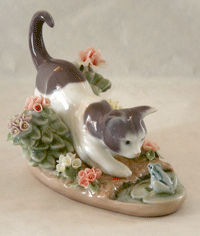
|
This clever little model #1442 has the too-cutesy English title, “Kitty Confrontation,” but there’s nothing kitschy about this model: anyone who knows cats can envision just such a scenario! Note the flowerwork in this model, the addition of which on any Lladró model is guaranteed to drive the price up at both retail and secondary markets. First issued in 1983, it has been a popular seller and still in production at a current retail price of $285.
|
Genuine Lladró brands. For the record, here are the brands and marks that can be directly attributed to Lladró or were very closely affiliated with it by virtue of their being designed by Lladró sculptors:
• Lladró (impressed in older models or marked with a blue backstamp and stylized lily logo);
• NAO (with impressed marks in older models or marked with a brown backstamp with or
without later ship logo);
• Zaphir (signed in a scripted green with no logo);
• Rosal (marked with an impressed name or a paper label also consisting of just the name);
• Tang (marked with an impressed or foil label consisting of stylized letters arranged within the
four rounded corners of a square);
• Hispania (an acquired non-porcelain ceramic company that Lladró kept in operation for only a
short time after acquisition); and
• Golden Memories (a translucent, light-bodied porcelain marked with a light-green name stamp
with logo of a child and dog lying in grass).
|
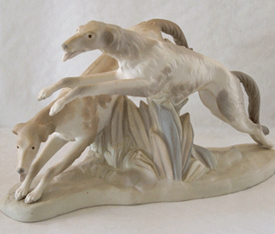
|
This large grouping of Borzoi dogs is marked with a cobalt blue stamp, “Made in Spain,” with no other mark. It is attributed to Tang, whose brand was marked with a foil paper label that easily came off. The brand is believed to have been started by a Lladró sculptor until a mutual lawsuit, in which the Lladró brothers prevailed, put the brand out of business.
|
Of these brands, only the core Lladró brand and NAO survive as retail entities; the others can be found only on the secondary market. Most of the earliest NAO models (i.e., with impressed marks) also showed up with early, impressed Lladró marks. All of these identical twins were the work of Lladró sculptor Fulgencio García, and the early, impressed marks on both indicate that NAO was around from the earliest days of the Lladró company.
|
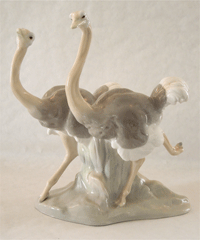
|
This early NAO grouping, c. early-to-mid-1960s, has an impressed NAO mark and is an identical twin to the same model from that era marked with an impressed Lladró mark, proving that the NAO brand has been around as long as Lladró itself. The sculptor for this and other older models cloned in both brands was the great Fulgencio García, who was responsible, more than anyone else, for developing the elongated style that would become associated with Lladró. Considered scarce with either mark, insurance replacement value for the Lladró-marked version at the prominent U.S. secondary market brokerage, A fction, is $2,400.
|
As an acquired brand, not all Hispania items were produced by Lladró, and those that were specifically indicate this in the mark. Most of the brand consisted of decorative housewares in a non-porcelain ceramic that were far afield of Lladró’s own aesthetic. Lladró did bring one innovation to the Hispania line before closing it, and that was a series of dogs, cats and wild animals in nearly life-size form.
The most commonly seen of the non-Lladró brands are Nadal, Rex, D’Art, Porceval, Pales, Raimond, and Casades, although there are many others. Of these, only Nadal, a company even older than Lladró, rivals Lladró in quality, but there is almost no information available to identify individual models in that brand. For the rest of these brands, placing any one of their models next to even the simplest Lladró will show an obvious difference in quality. Knowledgeable collectors stick to the brands made by Lladró.
|
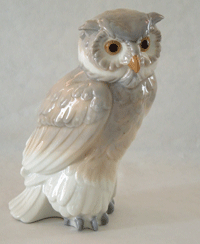
|
Zaphir brand “Eagle Owl” model #712. Zaphir ceased production in 1984. All of the models still in production that last year were folded into the NAO brand and retained the same serial number, so this model can be found with Zaphir or NAO marks. The NAO version was retired in year 2000 at a last retail price of $75.
|
Counterfeits and seconds. Lladró marks have gone through several iterations during the company’s history. The earliest marks for both Lladró and NAO by Lladró were impressed name marks without logo. In the case of the core brand, the first blue backstamp was very simple, consisting of the lily logo above the name and “Made in Spain.” As a historical oddity, the first Lladró backstamp also left the accent off the “O” at the end of the name. All of these marks are genuine and are, in fact, preferred by collectors as a means of distinguishing their particular examples of a given model from those produced later.
|
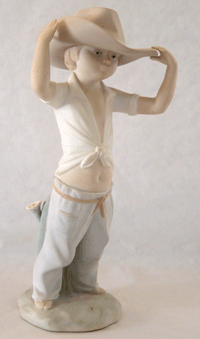
|
NAO model #182 in a matte (unglazed) finish is aptly titled, “Boy, Big Hat.” Modeling detail such as that in this figure is what makes Lladró great. This particular example has an early, impressed NAO mark; that and its low serial number date this particular firing from the late 1960s to about 1971. The model was in production for the next two decades, however, the matte version being retired in 1991 and the glazed version not until 2001. Although this means that there should be lots of this model available on the secondary market, it is not often seen. Estimated value: $150-$175.
|
As the most expensive of the brands, the regular Lladró line has attracted the attention of counterfeiters for the same reason counterfeiters are always drawn to expensive, prestige products: the money they stand to gain from the illicit trade in high-end brand names leverages their risk of getting caught. The quality of Lladró counterfeits, both of painting and modeling, is universally poor. Counterfeit marks will be the wrong color (e.g., a mulberry or gray vs. the cobalt blue of the genuine mark) and will have other irregularities, such as a nondescript slash where the copyright sign would be in later Lladró marks.
Lladró seconds and “gray market” sales outside Lladro’s own tightly controlled retail distribution system are identified by the scraping off of the stylized lily logo or other abraded elements of the mark. These abrasions will be clearly visible. Because porcelain collectors consider the mark to be integral to the integrity of a piece, Lladró with altered marks will have little value as long as pristine versions of the same model are still available on the secondary market.
|
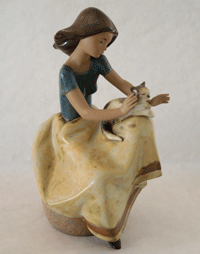
|
“Repose,” Lladró model #2169, is done in Lladró’s Gres semi-porcelain formula. The earthen tones of the ceramic body and the enamel paints give the Gres line a more rustic appearance than in Lladró’s other porcelains. The treatment was always more popular in Europe than in the U.S., and it is consequently difficult to find stateside. This model was retired from production in 2004 at a last retail price of $225.
|
A further word about values. Much of the Lladró currently circulating on the secondary market consists of relatively simple and modestly priced models. These include, for example, small white ducks and the famous “kids in nightshirts” series of children in long white gowns that could be purchased at retail for prices well below those of most other Lladró. It isn’t that these aren’t wonderful models in their own right; it’s just that they sold in large retail numbers precisely because they were affordable and gave cachet-conscious casual buyers the chance to “own a Lladró” at a reasonable buy-in. Because availability affects demand, sellers generally can’t expect to get top dollar for such readily available models; $100 or less would be the going rate.
|
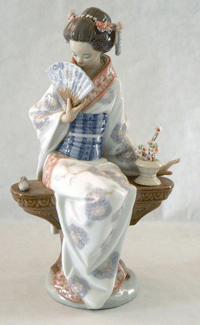
|
“Nippon Lady,” model #5327 was first issued in 1985 and retired in Year 2000. Despite the somewhat stereotypic presentation, the modeling detail in this figure is astonishing, from the separately articulated fingers to the embossed patterns in the kimono to that delicate bonsai done featuring Lladró’s famous flower work also gracing the woman’s hair. Asian themes have been very popular with Lladró collectors, and this model was on the retail market for several years, with collectors willing to shell out hundreds of dollars for it: last retail price was $575. Insurance replacement value today is $775 (price from A Retired Collection, whose prices are widely accepted as replacement values by the insurance industry). The model is seldom seen on the open secondary market.
|
However, even on eBay®, older items made in the 1950s to mid- to-late ‘60s and retired from production by early in the 1970s command high prices because, in the days before Lladró became famous, models were made in low production runs. For such items, serious buyers only need apply, and they should be prepared to shell out a few hundred dollars for scarce individual models and even a few thousand for more elaborate groupings – not bad, really, since Lladró porcelain is destined to become a treasured antique of the future.
|
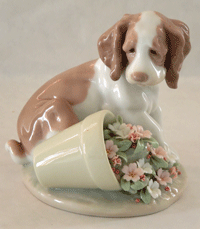
|
“It Wasn’t Me!” Lladró model #7672 from 1998 was one of the last annual figurines made exclusively for the now-defunct Lladró Collector’s Society. It was the only animal made for the company-sponsored LCS. Its retail price to club members was $295. A Retired Collection offers it today at $385, due in no small part to that tumbling flowerwork.
|
-------------------------------------------
Peggy Whiteneck is author of The Collector’s Book of Retired Lladró (Hampstead, MD: Old Line Publishing, 2010) and is recognized internationally as an expert in Lladró porcelain brands. She is also the author of two books on Fenton Art Glass, also from Old Line Publishing: Fenton Art Glass Beasts, Birds, and Butterflies (2012) and Fenton Art Glass Fairy Lamps and Lights, due out this year. Whiteneck also writes a monthly syndicated column for the trade press, “Good Eye: a Collector’s View of the Antiques and Collectibles Trade.”
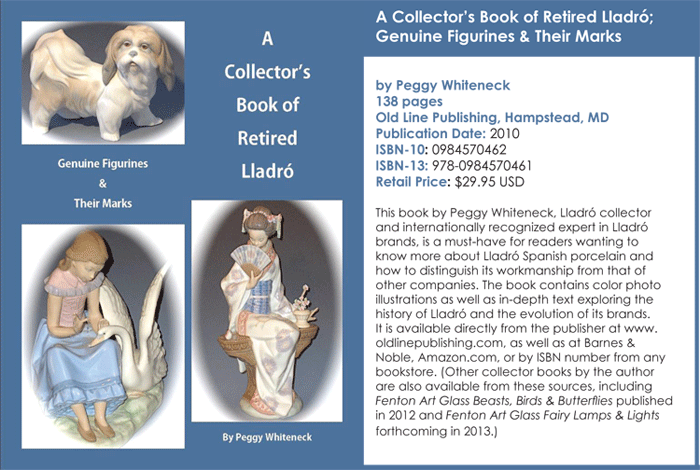
|